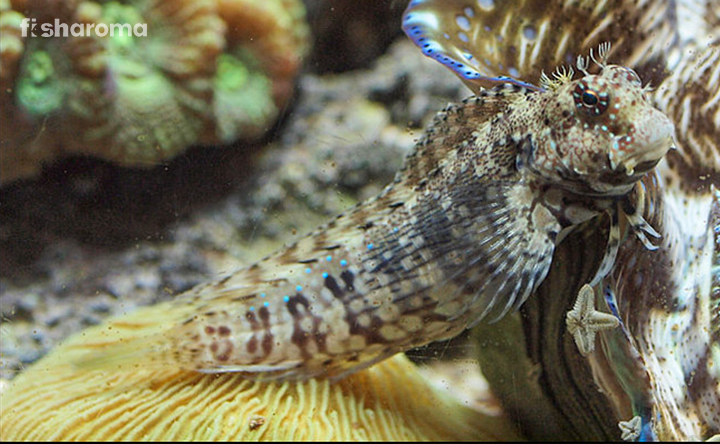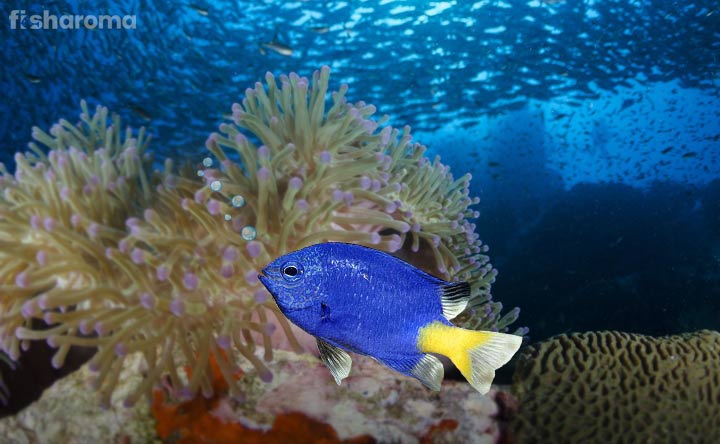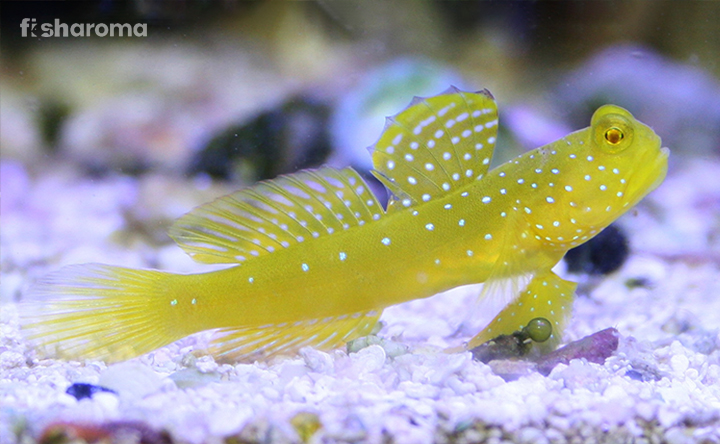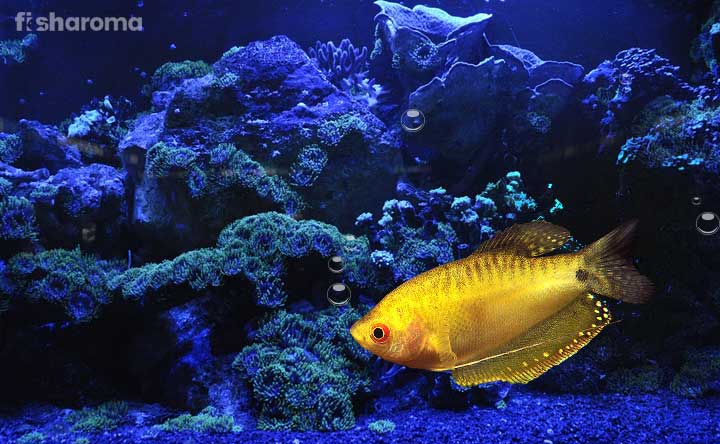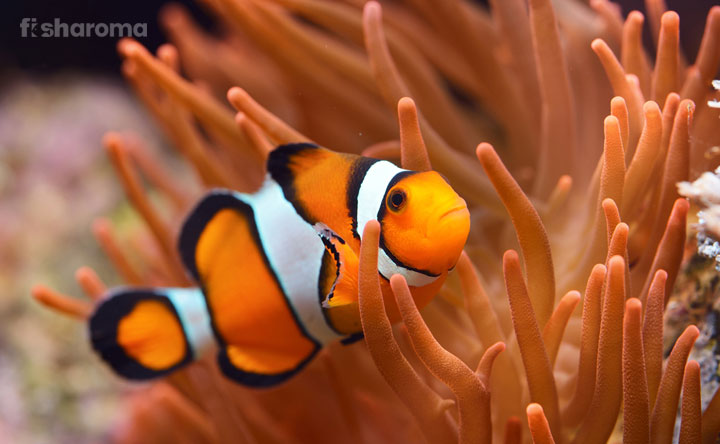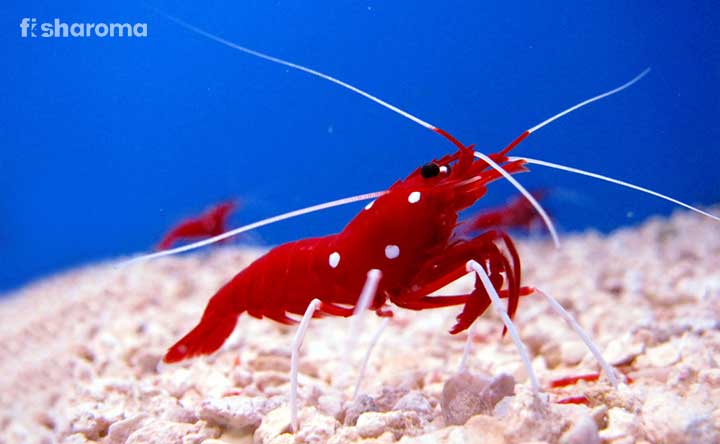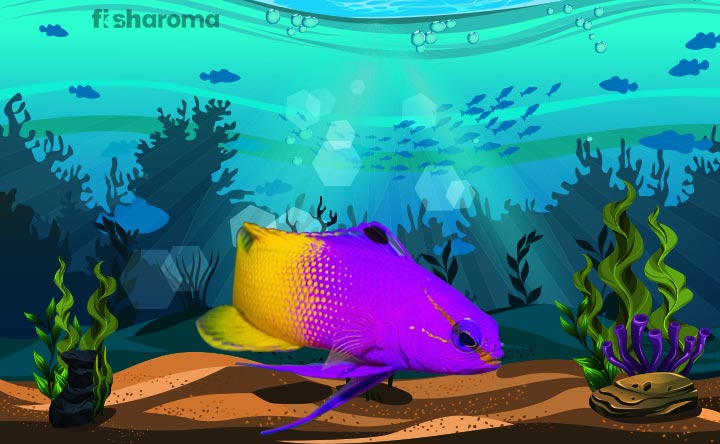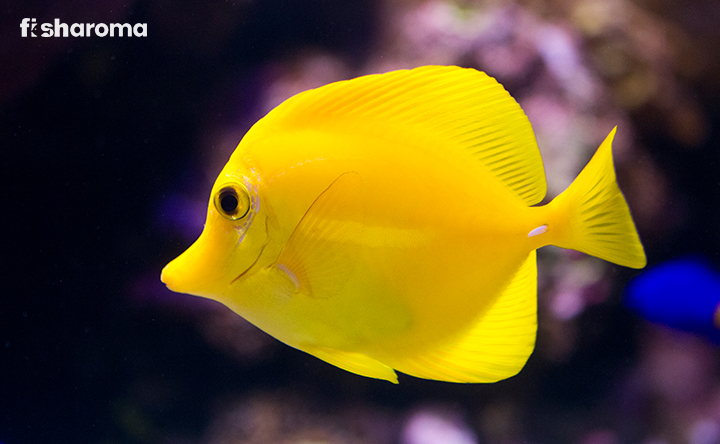Green Clown Goby- A Care Guide To Our Broad-barred Goby
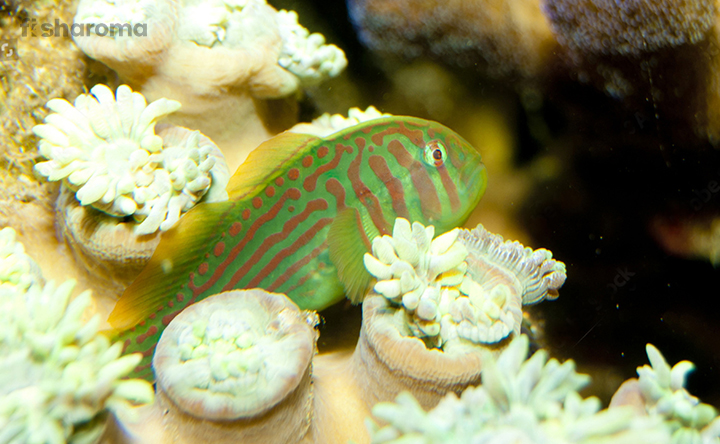
- Origin & Habitat of Green Clown Goby
- Appearance of Green Clown Goby
- Behaviour of Green Clown Goby
- Lifespan of Green Clown Goby
- Diet of Green Clown Goby
- Tank Requirements for Green Clown Goby
- Water Type for Green Clown Goby
- Compatibility of Green Clown Goby
- Breeding of Green Clown Goby
- Diseases of Green Clown Goby
- Summary
Green Clown Goby is known by several names, out of which, the most known names we know them by is Broad-barred Goby and Earspot Goby. This beautifully vibrant saltwater beauty is a highly sought after species. However, it’s a very small fish living a decent lifespan with peace. There has always been a matter of confusion with their taxonomy, as it is very evident from their striking similarities with Rippled Coral Goby (Gobiodon rivulatus).
This variant of Coral or Clown Goby is quite hardy, appearing quite accepting of a well-set captive situation. So, if you’re planning to get a marine or saltwater tank and you’re interested in making these unique beauties your very next addition, you’re in the right place. In this all-inclusive care guide, we’ll help you get your hands on every piece of information you need.
Key Specifications
Here goes a few key elements you need to check before you get started:
| Scientific Name | Gobiodon histrio (Paragobiodon xanthosomus) |
| Origin | Bantam, Tongatapu, Amis Islands, New Guinea, Thailand & Philippines. |
| Lifespan | 2-6 years |
| Colours/Patterns | A mix of orange patterns over green & accents of yellow. |
| Temperament | Peaceful, Territorial at times. |
| Size | 1.4 inches |
| Diet | Omnivorous |
| Family | Gobiidae |
| Compatibility | Compatible with small, peaceful fishes. |
| Tank size | 10-30 gallons |
| Care level | Moderate |
| Water preference | Saltwater |
Overview
Green Clown Goby (Gobiodon histrio) is a widespread marine water or saltwater fish species from the Gobiidae family. These omnivorous fishes have a moderate care level like most saltwater fish variants. The colourations, vibrancies and contrasts on them is a literal eye-candy. The compatibility of these fishes seems pretty good, except same species may situationally bother them. This variant of Goby tends to get territorial about their symbiotic mate, about which you’ll learn more as you proceed with this detailed care guide.
Origin and Habitat of Green Clown Goby
This lovely Goby fish species can be found majorly throughout the Pacific, precisely the East Indian Ocean. Other places include places like Australia, Japan, New Guinea and more. Seems like the spread of these beauties naturally, that it can be found as far as the Indonesian Complex. That, is basically a vast stretch of Indonesian Islands around which these fishes are found in large numbers.
These Gobies are exclusively found amidst the Bird’s Nest Coral branches. They are collectively known as Seriatopora hystrix, where you can only find them in pairs because of their monogamous nature.
Appearance of Green Clown Goby
This fish species is often mixed up with yet another fish species, known by the name of Rippled Coral Goby. However, as per studies, there are minute differences when it comes to the taxonomy here and there. Nevertheless, these fishes are captivating!
Let us brief you up a little on their isolated external features:
Colour
The colouration on the magnificent Green Clown or Coral Goby is beautiful. You can see a beautiful opal green with accentuated patterns of a radiant red on top. Visibly, a pretty brightly contrasted vibrancy on these fishes is something you would notice. The patterns appear longitudinal and wiggly, if we briefly try to explain how do they exactly appear. There are not many beautifully green marine fishes out there, making their colours stand out.
Size
The Goby fishes are not that big in size. Most of them are under 2 inches, where the average size is 1.4 inches.
Behaviour of Green Clown Goby
Let’s break it down a little and study the details of their behavioural patterns, bit by bit.
Detailed overview & their symbiotic relationship
Moving onto their behavioural patterns, this species clearly likes to hide in crevices at times. The Green Clown Goby fishes share a symbiotic relationship with Acropora Coral species. Basically, a symbiotic bond or relationship is where two or more individuals of completely different species share a co-dependant bond.
It is definitely more like a give and take, where the SPS coral provides your precious Goby fish with shelter. In return, the fish provides the corals with virtual mobility or food. Studies have shown that these Acropora species actually secrete some sort of mysterious chemical, more like a categorized “smell of distress” which fetches the fish’s attention.
The Corals mostly secrete the same at the time of breeding, remove predators or even actually get rid of nearby corals. Sounds like a pretty secure shelter for the fishes.
Mannerisms
Now more on their mannerisms, the Green Clown Gobies are generally peaceful but signs of territorial nature were seen. Basically, these fishes protect the Acropora Corals in any way they can.
So, if a different marine fish in the wild is seen to invade their space, they tend to get defensive. Other than that, the only other time they get defensive is when there’s algae overgrowth that can potentially kill the host. Hence, making your Gobies taking care of the situation by killing them off or getting rid of them in some way.
Conclusive view
You see, everything in this universe is dependent on each other, so a symbiotic relationship for a marine fish species doesn’t really sound that surprising. In a captive scenario, territorial traits are not that visible, however. It has also been noticed that they tend to get a little aggressive against other Clown Goby fishes.
It’s best to pair them up with peaceful tank mates in order to not test their limits. Conclusively, they can easily fit in, in your wonderful reef tank. This is because they are not only reef-safe, but share a special bond of co-dependency with a coral type. No matter how peaceful they may be, they also have host-nibbling tendencies. These Gobies will not hesitate and show aggression to other delicate species if need be.
Lifespan of Green Clown Goby
The Green Clown Goby has a classic lifespan of 2-6 years, which can even go as high as 7 years. As long as you keep their situations comfortable and parameters looked after, they can make the most out of their lifespan.
Diet of Green Clown Goby
The best way to feed your precious Green Clown Goby is to put the food near their hiding spot. Since, they mostly prefer to hide it’s best to do so. Since they are carnivorous in nature, you will often see them nibbling on their own Acropora host. They do have situationally omnivorous tendencies, but that’s rare.
Let’s have a quick look at their diet:
- Amphipods
- Copepods
- Zooplankton
- Benthic invertebrates
Tank Requirements for Green Clown Goby
Let’s have a look at the things you must keep in mind:
Tank Lid
It is true, Clown Gobies can actually turn out to be great jumpers! But if you notice the behaviour of our precious Green Clown Goby, they prefer to latch themselves to the corals. Still, as it is in their nature, there is a possibility of them jumping to their deaths. This is where, a tank lid plays a major part, preventing that situation from happening.
Other than that, a tank hood in general, provides protection against dust particles from polluting the water. That, ultimately can hamper the health of the fishes in your well-set reef tank. Also, you don’t want any curious cat to explore and harm your fish either, hence, a tank hood also acts as a shield against house pets.
Tank Size
From a general point of view, most Gobies are hardy or small enough to properly exist in a nano tank. Still, the recommended tank size is a minimum of 10 gallons. We recommend you to switch to a 30-gallon tank at least, as they grow in size with age.
Substrate
It’s best to opt for a smooth substrate with fine elements in your reef tank, especially when you have these Green Coral Gobies in it. Any rough substrate or sharp rocks or grains can disrupt or even damage the mucus coating containing toxins. You shouldn’t have to compensate for it with additional nutrition arrangements or calories, so it’s better to provide them with the preferred fine substrate like sand.
Filter
Make use of a strong filter, as the waste production is high. The ammonia and nitrate levels get intense, so it’s best to make use of an appropriate filter to take care of that.
Caution- Don’t forget to block the filter openings with nets or something similar. The Green Clown Gobies can be comparatively calmer than the other Clown Goby fish variants, but they generally have a tendency of getting stuck in the filters.
Ornaments
These lovelies rarely nibble on some host corals from time to time, it’s safe to consider that they are mostly reef-safe in nature. Therefore, you can go crazy with the wonderfully vibrant coral decor! Add life to your magnificent saltwater tank with this simple addition.
Lighting
Keep the lighting optimized well, with intensities on the lower side. Emulate their natural sun exposure well with the lighting set-up you provide in your tank. These Gobies mostly prefer to hide out, so it’s best to assume a bright lighting is not suitable for them.
Presence of Flora
You can consider choices of vegetation like Green finger Algae, Mermaid’s fan or Seagrass. The Green Coral Gobies have “Coral” in their name for a reason. It’s fine if you just have good amounts of different coral varieties, more like a well-constructed colony for little nibbling incidents to not bother the balance much. Keep vegetation decorational and mellow, as these beauties will mostly spend their time hiding out in the creeks and crevices of your reef colony.
Cleaning Method
Keep the tank environment clean, by properly cleansing the substrate from time to time and performing a proper water replacement procedure. Clean the tank walls with a proper cloth. Keep an eye out for the corners of your tank and get rid of any waste elements. Good maintenance is important, especially if you want to keep all the health risks away for your precious aquarium buddies.
Water Type for Green Clown Goby
Water Type or the water parameters are of ultimate importance, especially when it comes to the health of the fish. Other than tank size or other requirements, the water profile is truly responsible for balancing the overall tank environment.
Moving forward, we know the importance of a proper water profile. Let us have a look at a few things you may need to know:
| Hardness | 8-12 dKH |
| Temperature | 22-25 Degrees Celsius |
| pH | 8.1-8.4 |
| Gravity | 1.020-1.025 |
Hardness
The water hardness, precisely the carbonate hardness should be at least 8-12 dKH. Seems like they really prefer slightly hard water in their aquarium.
Temperature
The temperature range is textbook, where the temperature is balanced. The range should be 22-25 Degrees Celsius.
pH
The pH should be at least be 8.1, where the max you could go is 8.4.
Gravity
The gravity range of this fish should at least be 1.020-1.025.
Compatibility of Green Clown Goby
The Green Clown Goby fish is usually peaceful, but you can evidently notice incompatibility with other Gobies. It’s best to pair them up with shy and peaceful species. Other than that, let’s give you a more detailed look!
Suitable Tank mates
It is possible to keep them with peaceful bottom-dwellers like Plecos or Snails. Remember to make your mate choice hardy. If the other tank buddies are too vulnerable, like Cherry Shrimps and if by mistake put a step in their territory, they will get fatally attacked. The most appropriate fish species to share a tank with them would be shy and docile beings who like to mind their own business, or hide out much like them. You can certainly pair them up with Yellow Clown Goby or Firefish, nevertheless.
Unsuitable Tank mates
Don’t pair them up with other Goby species, as they show signs of aggression at the sight of them. They have high territorial instincts when it comes to their Coral colony invasion, so it’s best to keep social or curious species away. Don’t pair them up ever with other large or aggressive marine fish choices, as your precious Gobies may end up
Breeding of Green Clown Goby
These schooling fishes can exist up to 20 fishes at a time, due to their less space consumption and small size. Green Clown Goby fishes much like other Clown Goby species are protogynous hermaphrodites. All of the fishes are born female as juveniles. But in the case of Clown Gobies in general, there’s a concept of bi-directional alterations in sex.
Detailed view
Basically, to explain this in the simplest way possible if the two females pair up when they are about to reach the mate-able age, one of the fishes turn into a male and the other stays a female. However, the vice-versa can also happen where if two males pair up, one of them end up turning into a female.
So, no matter what pair of these magnificent Green Clown Gobies you may have, they end up turning into a breed-able pair eventually. To be really detailed, you can notice it is always the bigger one that turns into a male, whereas the smaller one usually turns or remains a female. Thus, bi-directional.
All of these sub-processes fall under the parent category of sequential hermaphroditism, which is the sort to only happen to plants, gastropods and lastly, fishes.
Laying the eggs
This sounds incredible but the female fishes can lay up to a staggering 1000 eggs! You will often find their eggs around the tentacle-region of their host coral, well protected in the coral colony. The father fish usually acts as a guard to the eggs, where it takes about 5 days for them to hatch. The breeding tank for the Gobies don’t require any special or enhanced parameters, it’s fine if it’s the same as the community tank you keep them in.
Just remember that whatever tank they’re bred in, there should be a well-built preferred density of corals. That provides the parent fishes a sense of security and comfort, to breed and proceed to the following actions, in peace. However, it is evident that you don’t have to break a sweat to breed them, but to make the fries survive post-hatch is quite a task.
Breeding in captivity
It is very complicated to make them survive under captive conditions, as artificially induced environments may not exactly tend to their requirements as such. The juveniles require a special diet, at least for the first two weeks since birth. It’s known as rotifers, which are found mostly in freshwaters over saltwater or even brackish.
It’s good to make a mixture of brine shrimp nauplii or even capsulated brine shrimp. After a certain time (25 days approximately) stop with the special diet. Technically after around 6 weeks, you can start feeding the little clown gobies some dry food, mixed well.
The only way to tell if you were successful in taking care of the juveniles is when you see them colours popping out of the young beauties, that is, if they manage to live for that long. Make sure you make the necessary water replacements (at least 50%) while you’re monitoring them in the breeding tank. Transfer them with protection when they are big enough to join your majestic marine community and thrive!
Diseases of Green Clown Goby
Green Clown Goby fishes are quite prone to the common saltwater diseases. Let’s have a close-up look at how it looks like and what could it possibly be.
If you see changes like:
- Pale or pinkish skin colouration.
- White spots or dots over the fins or body sections.
- Frayed fins (Caudal)
- Black spots
- Loss of appetite
- Unusual behaviour
- Unexpected bumps on the body.
It could possibly be:
- White Spot Disease or Ich
- Black Spot Disease (Turbellarian flat-worm infection)
- Other bacterial or parasitic ailments, especially the ones that commonly affect saltwater fishes can certainly affect your precious Gobies too.
- Malnourishment is also a serious concern, especially when you freshly purchase them. You will often see them changing colours as a result, which is not good. Your Green Clown Goby should always be vibrant and happy, that’s the only sign of good health you could possibly expect.
Treatment
A few ways of prevention and treatment are as follows:
- Firstly, don’t forget to isolate the fish from the community tank in order to avoid any further spread of disease they are carrying.
- Make sure you do the freshwater dip treatment, where you dip the affected fish in freshwater for at least 5 minutes.
- You can treat diseases like Black spots, which is ideally a flat-worm infection with compositions like Levamisol or Praziquantel. It actually works!
- Make sure whatever medication you choose is reef-safe.
- Keep an eye out for early detection, so that you can tend to their ailments as soon as possible without the possibility of further spread.
- Don’t forget to use a test kit from time to time, just to be careful.
- Opt for herbal medicinal resources, it’s beneficial for delicate fishes like our very own Green Clown Goby.
- Keep the tank well-oxygenated at all times.
Summary
The Green Clown Goby fishes are magnificent species of beauty and personality. From their unique symbiotic relationship with a coral host to the interesting breeding process, everything is fascinating to witness. So if you have it in you as a fellow aquarist, this beautiful saltwater fish is the best choice to make as your brand new marine tank addition! So, what are you waiting for? Welcome them into your beautiful community of fishes and experience the ultimate parrot-like fish peeking at you through your coral community.
Similar Care Guides You may like
- Bellus Angelfish Care Guide: This lovely saltwater angelfish from the coastal waters never fail to amaze you with their colouration and bold patterns. Who doesn’t want them in their tank? Know more about them right here.
- Spotted Garden Eel Care Guide: This unique ray-finned marine beauty has incredible burrowing technique, which is so interesting to watch. Click right here to know more about them.
- Panther Grouper Care Guide: Want something in your precious saltwater tank that exactly looks like an adorable polka-dotted ball of love? Of course you do. These Groupers live for 20 long years and are easy to care for. To know everything about this all-rounder, check this out!

